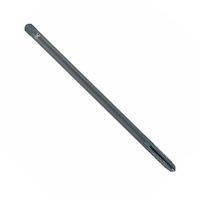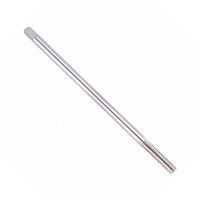Call +(254) 703 030 000 / 751 483 999 / 721 704 777
- Home
- Machining
- Threading
- Taps Internal Threading Tools
- Extension Nut Pulley Taps
.....Read More
Frequently Asked Questions
What are extension taps used for?
Extension taps are used to create internal threads in deep or hard-to-reach holes where standard taps cannot reach. They are designed with a longer shank, allowing them to extend further into a workpiece. This makes them ideal for applications in industries such as automotive, aerospace, and manufacturing, where components often have deep cavities or require threading in confined spaces. Extension taps ensure precision and accuracy in threading operations, maintaining the integrity of the workpiece while providing the necessary reach. They are available in various sizes and thread types to accommodate different materials and specifications.
How do nut taps differ from standard taps?
Nut taps are specialized tools designed specifically for cutting threads in nuts or similar components, whereas standard taps are more general-purpose tools used for creating internal threads in a variety of materials. The key differences between nut taps and standard taps include:
1. **Flute Design**: Nut taps typically have fewer flutes compared to standard taps. This design allows for more efficient chip removal, which is crucial when threading nuts, as it prevents clogging and ensures smoother operation.
2. **Length**: Nut taps are generally shorter than standard taps. The shorter length is advantageous when working with nuts, as it provides better control and reduces the risk of breakage.
3. **Threading**: Nut taps are designed to cut threads more quickly and efficiently in softer materials, such as those used in nuts. They often have a more aggressive cutting action compared to standard taps, which are designed for a wider range of materials and may require more passes to achieve the desired thread depth.
4. **Material and Coating**: Nut taps are often made from high-speed steel or other durable materials and may have specialized coatings to enhance performance and longevity. Standard taps also come in various materials and coatings, but the selection is broader to accommodate different applications.
5. **Application**: Nut taps are specifically used for threading nuts and similar components, making them ideal for high-volume production environments where speed and efficiency are critical. Standard taps are more versatile and can be used for a wide range of threading tasks in different materials and thicknesses.
In summary, nut taps are optimized for speed and efficiency in threading nuts, with design features that facilitate quick chip removal and reduce the risk of tool breakage, while standard taps offer versatility for a broader range of threading applications.
What is the purpose of pulley taps?
Pulley taps are specialized tools used primarily in the automotive and mechanical industries to clean and restore the threads of pulleys, particularly those found on engines and other machinery. The primary purpose of pulley taps is to ensure that the threads within a pulley are clean, precise, and free from damage or debris, which is crucial for the proper functioning of the pulley system.
When a pulley is used over time, its threads can become worn, corroded, or filled with debris, which can lead to improper fitment of bolts or other components. This can cause misalignment, slippage, or even failure of the pulley system, leading to mechanical issues or breakdowns. Pulley taps are designed to address these issues by re-cutting or cleaning the threads, ensuring they are in optimal condition for secure and accurate assembly.
Pulley taps are typically made from high-strength steel or other durable materials to withstand the rigors of cutting through metal. They come in various sizes and thread pitches to match the specific requirements of different pulleys. The use of pulley taps can extend the life of pulleys and associated components, reduce the risk of mechanical failure, and ensure the efficient operation of machinery.
In summary, the purpose of pulley taps is to maintain the integrity and functionality of pulley systems by ensuring that the threads are clean, precise, and capable of securely holding bolts and other components. This maintenance is essential for the reliability and safety of mechanical systems that rely on pulleys for operation.
How do you choose the right tap for deep hole threading?
To choose the right tap for deep hole threading, consider the following factors:
1. **Material Compatibility**: Select a tap material and coating that matches the workpiece material. High-speed steel (HSS) taps are versatile, while cobalt or carbide taps are better for hard materials.
2. **Tap Type**: Use spiral flute taps for blind holes to efficiently evacuate chips upwards. For through holes, spiral point taps push chips forward, reducing clogging.
3. **Thread Depth**: Ensure the tap has sufficient length to reach the required thread depth. Long shank taps or extension taps may be necessary for very deep holes.
4. **Thread Form**: Choose the correct thread form (e.g., UNC, UNF, metric) based on the application requirements.
5. **Coating**: Consider coatings like TiN, TiCN, or TiAlN to reduce friction, enhance wear resistance, and improve chip flow.
6. **Lubrication**: Use appropriate cutting fluids to reduce heat and friction, which is crucial for deep hole threading.
7. **Machine Capability**: Ensure the machine has the necessary power and rigidity to handle deep hole tapping without deflection or vibration.
8. **Chip Evacuation**: Ensure effective chip removal to prevent clogging and tap breakage. Use taps with appropriate flute designs and consider peck tapping if necessary.
9. **Tapping Speed and Feed**: Adjust speed and feed rates to suit the material and tap type, ensuring smooth operation and preventing tap breakage.
10. **Pilot Hole**: Drill an accurate pilot hole with the correct diameter to ensure proper thread engagement and reduce tap wear.
By considering these factors, you can select a tap that ensures efficient, accurate, and durable deep hole threading.
What are the benefits of using extension taps?
Extension taps offer several benefits:
1. **Increased Accessibility**: They allow you to access power outlets that are otherwise hard to reach, making it easier to plug in devices without rearranging furniture.
2. **Multiple Outlets**: Extension taps often come with multiple outlets, enabling you to power several devices simultaneously from a single wall socket.
3. **Space Efficiency**: By providing additional outlets, they reduce the need for multiple power strips, helping to declutter spaces and manage cables more effectively.
4. **Versatility**: They can be used in various settings, including homes, offices, and workshops, to accommodate different power needs.
5. **Surge Protection**: Many extension taps come with built-in surge protectors, safeguarding your electronic devices from voltage spikes and electrical surges.
6. **Portability**: Lightweight and easy to move, extension taps can be conveniently relocated to different areas as needed.
7. **Cost-Effective**: They are generally affordable and provide a cost-effective solution for expanding power access without the need for additional electrical installations.
8. **Safety Features**: Modern extension taps often include safety features such as child-proof outlets, overload protection, and power switches to prevent electrical hazards.
9. **Energy Efficiency**: Some models come with energy-saving features, like individual switches for each outlet, allowing you to turn off devices when not in use.
10. **Customization**: Available in various designs and lengths, they can be tailored to fit specific needs and preferences, whether for home entertainment systems or office setups.
11. **Convenience**: They simplify the process of connecting and disconnecting devices, reducing wear and tear on wall outlets.
Overall, extension taps enhance the functionality and safety of electrical systems by providing flexible, efficient, and secure power distribution solutions.
Can nut taps be used for other applications besides threading nuts?
Yes, nut taps can be used for applications beyond threading nuts. They are versatile tools primarily designed to cut internal threads in pre-drilled holes, allowing nuts to be screwed onto bolts or screws. However, their utility extends to several other applications:
1. **Repairing Damaged Threads**: Nut taps can be used to repair or clean up damaged or corroded threads in existing holes, restoring them to a functional state.
2. **Creating Custom Threaded Holes**: They can be employed to create custom threaded holes in various materials, such as metal, plastic, or wood, for bespoke projects or repairs.
3. **Prototyping and Fabrication**: In prototyping and small-scale fabrication, nut taps are useful for creating threaded holes in components that need to be assembled and disassembled frequently.
4. **Machinery Maintenance**: In maintenance and repair operations, nut taps can be used to ensure that threaded holes in machinery and equipment remain in good condition, preventing downtime due to thread failure.
5. **Metalworking and Woodworking**: In both metalworking and woodworking, nut taps can be used to add threaded holes to projects, allowing for the attachment of additional components or fixtures.
6. **Automotive and Aerospace**: In automotive and aerospace industries, nut taps are used for creating and maintaining threaded holes in engine components, frames, and other critical parts.
7. **DIY Projects**: For DIY enthusiasts, nut taps can be used in various home improvement projects, such as installing fixtures or creating custom furniture.
Overall, while nut taps are primarily designed for threading nuts, their ability to create and maintain threaded holes makes them valuable tools in a wide range of applications across different industries.
How do pulley taps ensure alignment during threading?
Pulley taps ensure alignment during threading by utilizing a combination of mechanical design and operational technique. The key to their effectiveness lies in their ability to maintain consistent axial alignment with the workpiece, which is crucial for producing accurate and clean threads.
1. **Design Features**: Pulley taps are designed with a straight shank and a tapered cutting edge. This design helps in centering the tap as it enters the hole, reducing the risk of misalignment. The taper allows for gradual engagement with the material, minimizing lateral forces that could cause the tap to deviate from the intended path.
2. **Guidance Mechanism**: Many pulley taps are used in conjunction with a tapping guide or jig. These guides hold the tap perpendicular to the workpiece surface, ensuring that the initial entry is aligned correctly. This setup is particularly useful in manual operations where human error could lead to misalignment.
3. **Balanced Forces**: The symmetrical design of pulley taps helps distribute cutting forces evenly around the tap's circumference. This balance prevents the tap from being pushed off course during the threading process, maintaining alignment throughout the operation.
4. **Operational Technique**: Proper technique is essential for maintaining alignment. Operators are trained to apply consistent pressure and use appropriate speeds to avoid skewing the tap. Additionally, reversing the tap periodically to clear chips can prevent binding and maintain alignment.
5. **Use of Lubricants**: Applying cutting lubricants reduces friction and heat, which can cause the tap to wander. Lubricants help in smooth cutting and maintaining the tap's path.
By combining these design features and techniques, pulley taps effectively ensure alignment during threading, resulting in precise and reliable threads.


